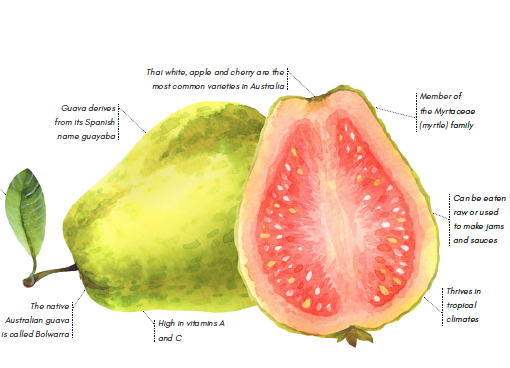Origins
Guava is part of the myrtle family Myrtaceae, which includes flowering plants and shrubs such as eucalyptus and pimenta (allspice). Due to its widespread cultivation through humans and animals, guava’s origins are not known, but it is thought to have roots in northern South America and Peru, where it was first domesticated.
Now, the fruit is commonly grown in tropical and subtropical areas across the world, most notably in South America, India and Mexico. Guava is also found in Queensland, the Northern Territory and Northern New South Wales, along with the native Australian guava Bolwarra, which is grown in rainforest areas across Queensland and in Victoria.
Growth and harvest
Guava trees prefer tropical climates, but are quite resilient and can withstand dry conditions better than most tropical fruits. The trees thrive in areas with full to mid sunlight that have rich, well-draining soil. While tough, guava trees don’t do well in
frost and also need to be protected from heavy winds.
Trees can grow up to 6 metres in height and have wide canopies with greenish bark and long, green leaves. Small white flowers bloom in clusters of two or three before producing pear-like fruits which are typically green, but can also be yellow and dark red depending on the variety and stage of ripening. Guava trees can bloom throughout the year, but usually flower at the beginning of warmer weather in spring.
Appearance and flavour profile
There are many types of guava, but Thai white, apple and cherry guavas are the most common in Australia. Thai white guavas have green skin with white flesh and are mild in sweetness compared to pink-fleshed types. Apple guavas have green skin and pink flesh, while cherry guavas are smaller and have red skin with juicy, white flesh.
The flavour of guava is both sweet, savoury and sometimes tart, with the fruit commonly described as being a mix between a strawberry and a pear. Texture-wise, guavas are crunchy and have a floury, gritty and pear-like flesh.
Culinary applications
Guava lends itself to both food and beverage purposes thanks to its sweet, tangy and savoury flavour profile. It plays a significant role in South American cookery where it is used in the conserve goiabada served with cheese along with glazes for grilled proteins. It is also a core ingredient in agua fresca, which is a beverage consumed across Mexico.
Due to its high levels of pectin, guava is a go-to ingredient for making fruit pastes,
jellies and jams. Guava can be eaten raw and whole, with the skin containing most of the fruit’s vitamin C levels.
Drinks-wise, guava regularly makes an appearance in smoothies and juices, not only for its taste, but also for its high levels of vitamins along with fibre and potassium.

